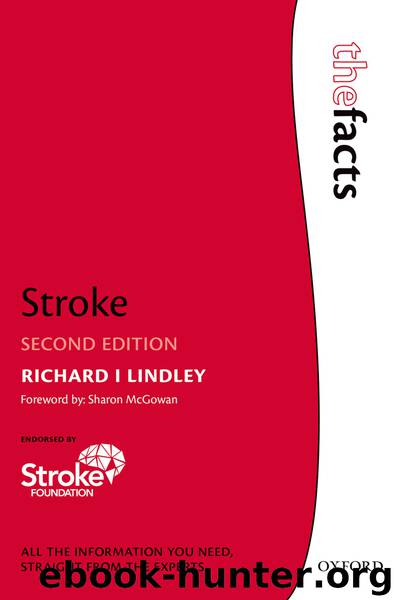Stroke by Lindley Richard I.;

Author:Lindley, Richard I.;
Language: eng
Format: epub
Publisher: Oxford University Press
Published: 2017-01-15T00:00:00+00:00
Figure 6.2 Lateral view of the brain showing the motor, visual, and sensory areas.
Figure 6.3 The motor cortex of the brain, illustrating the position of the grey matter responsible for different areas of the body—the homunculus.
If we now put this very quick and grossly simplified lesson in neuro-anatomy together with our knowledge of the blood supply to the brain, we can start to understand the stereotyped patterns of problems arising from stroke. It is easier to start understanding these concepts by considering the likely stroke problems when particular blood vessels become blocked, i.e. ischaemic stroke. Haemorrhagic stroke, by virtue of the spread of blood in the haematoma, does not necessarily follow the same patterns of stroke deficit, and this can often be a clue that you are dealing with a bleed rather than an ischaemic stroke. In the 1980s a group of researchers in Oxford summarized the main patterns of stroke problems (deficits) arising from ischaemic stroke, and this classification is in widespread use in hospitals in the UK and beyond. This Oxfordshire Community Stroke Project (OCSP) classification helps us understand the main impairments associated with different sorts of stroke and divides ischaemic stroke into four main groups:
◆total anterior circulation infarct (TACI);
◆partial anterior circulation infarct (PACI);
◆lacunar infarct (LACI);
◆posterior circulation infarct (POCI).
Download
This site does not store any files on its server. We only index and link to content provided by other sites. Please contact the content providers to delete copyright contents if any and email us, we'll remove relevant links or contents immediately.
When Breath Becomes Air by Paul Kalanithi(7276)
Why We Sleep: Unlocking the Power of Sleep and Dreams by Matthew Walker(5665)
Paper Towns by Green John(4179)
The Immortal Life of Henrietta Lacks by Rebecca Skloot(3834)
The Sports Rules Book by Human Kinetics(3599)
Dynamic Alignment Through Imagery by Eric Franklin(3504)
ACSM's Complete Guide to Fitness & Health by ACSM(3475)
Kaplan MCAT Organic Chemistry Review: Created for MCAT 2015 (Kaplan Test Prep) by Kaplan(3431)
Introduction to Kinesiology by Shirl J. Hoffman(3308)
Livewired by David Eagleman(3137)
The River of Consciousness by Oliver Sacks(2999)
Alchemy and Alchemists by C. J. S. Thompson(2918)
The Death of the Heart by Elizabeth Bowen(2911)
Descartes' Error by Antonio Damasio(2746)
Bad Pharma by Ben Goldacre(2738)
The Gene: An Intimate History by Siddhartha Mukherjee(2502)
Kaplan MCAT Behavioral Sciences Review: Created for MCAT 2015 (Kaplan Test Prep) by Kaplan(2495)
The Fate of Rome: Climate, Disease, and the End of an Empire (The Princeton History of the Ancient World) by Kyle Harper(2444)
The Emperor of All Maladies: A Biography of Cancer by Siddhartha Mukherjee(2440)
